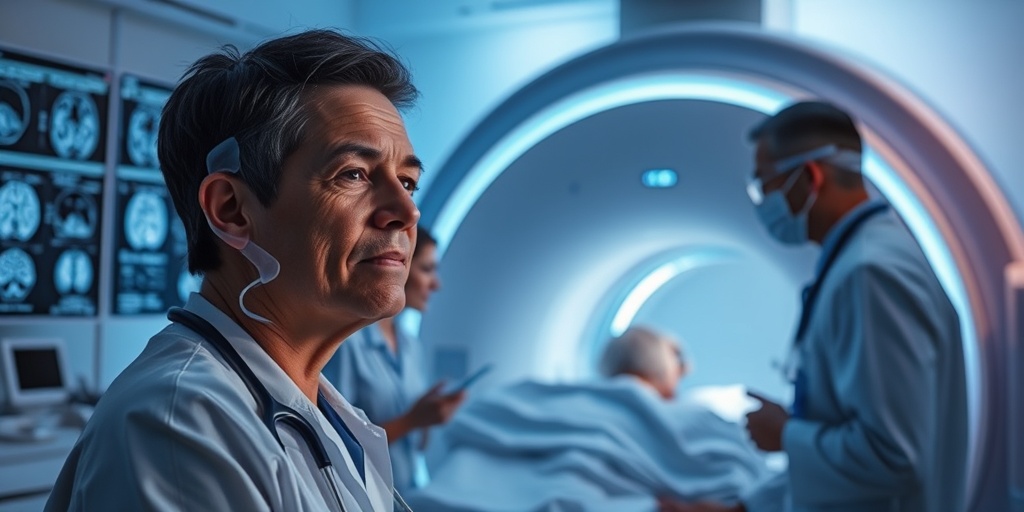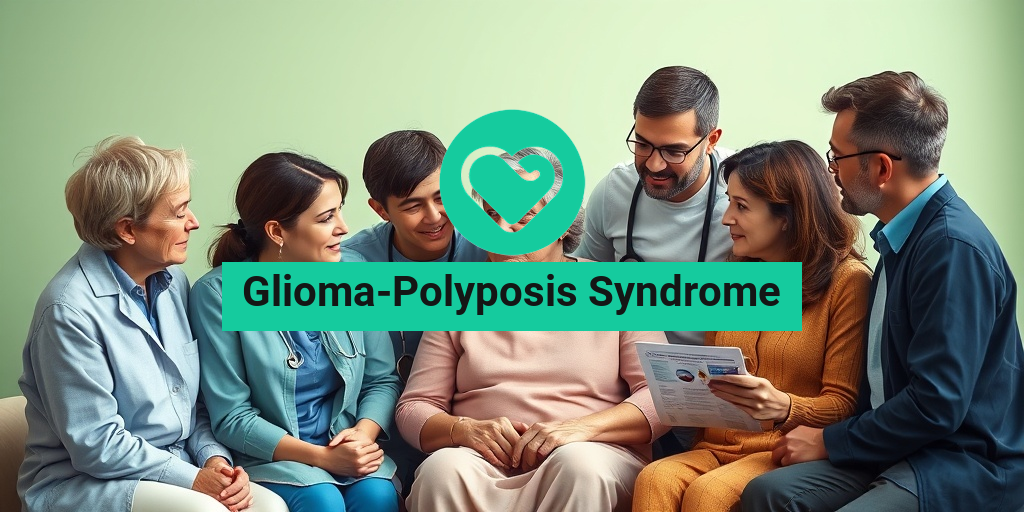What Is Glioma-Polyposis Syndrome?
Glioma-Polyposis Syndrome is a rare genetic condition characterized by the presence of both gliomas, which are a type of brain tumor, and polyps in the gastrointestinal tract. This syndrome is often associated with mutations in specific genes, leading to an increased risk of developing these tumors and polyps. Understanding this syndrome is crucial for early detection and management, as it can significantly impact the quality of life for those affected.
Understanding Gliomas
Gliomas are tumors that arise from glial cells in the brain or spinal cord. They can vary in type and severity, ranging from benign to malignant. The most common types of gliomas include:
- Astrocytomas: These tumors develop from astrocytes, star-shaped cells that support nerve cells.
- Oligodendrogliomas: Originating from oligodendrocytes, these tumors are typically slower-growing.
- Glioblastomas: The most aggressive form of glioma, glioblastomas are known for their rapid growth and poor prognosis.
Polyps and Their Implications
Polyps are abnormal growths that can occur in various parts of the gastrointestinal tract, particularly in the colon. While many polyps are benign, some can develop into colorectal cancer over time. Individuals with Glioma-Polyposis Syndrome are at a heightened risk for these growths, making regular screening and monitoring essential.
Genetic Factors
The genetic basis of Glioma-Polyposis Syndrome often involves mutations in genes such as APC (Adenomatous Polyposis Coli) and TP53. These mutations can disrupt normal cell growth and division, leading to the development of tumors and polyps. Genetic counseling and testing can be beneficial for individuals with a family history of this syndrome, as early intervention can improve outcomes.
Glioma Symptoms
Recognizing the symptoms of gliomas is vital for timely diagnosis and treatment. Symptoms can vary depending on the tumor’s location, size, and type. Here are some common symptoms associated with gliomas:
Neurological Symptoms
As gliomas develop in the brain, they can lead to various neurological symptoms, including:
- Headaches: Persistent or worsening headaches that may be different from usual headaches.
- Seizures: New-onset seizures can occur, even in individuals without a prior history of epilepsy.
- Cognitive Changes: Memory problems, difficulty concentrating, or changes in personality can arise.
- Vision or Hearing Problems: Blurred vision, double vision, or hearing loss may occur depending on the tumor’s location.
Physical Symptoms
In addition to neurological symptoms, individuals may experience physical symptoms such as:
- Nausea and Vomiting: Increased intracranial pressure can lead to nausea and vomiting.
- Weakness or Numbness: Weakness or numbness in limbs may occur, particularly if the tumor affects motor pathways.
- Balance Issues: Difficulty with coordination and balance can be a sign of a brain tumor.
When to Seek Medical Attention
If you or a loved one experiences any of these symptoms, especially if they are new or worsening, it is crucial to seek medical attention promptly. Early diagnosis and treatment can significantly improve outcomes for individuals with gliomas.
For those navigating the complexities of Glioma-Polyposis Syndrome, resources like Yesil Health AI (yesilhealth.com) can provide valuable, evidence-based health answers. Staying informed and proactive about health can make a significant difference in managing this condition.
In conclusion, understanding Glioma-Polyposis Syndrome and its associated symptoms is essential for early detection and effective management. By being aware of the signs and seeking timely medical advice, individuals can take control of their health and improve their quality of life. 🌟

Polyposis Symptoms
Polyposis is a condition characterized by the presence of multiple polyps in the gastrointestinal tract, particularly in the colon. These polyps can vary in size and number, and while many are benign, some can develop into cancer over time. Recognizing the symptoms of polyposis is crucial for early diagnosis and management. Here are some common symptoms associated with polyposis:
1. Abdominal Pain and Discomfort
Individuals with polyposis often experience abdominal pain or discomfort. This pain can range from mild to severe and may be intermittent or constant. It is essential to pay attention to any persistent discomfort, as it could indicate complications.
2. Changes in Bowel Habits
One of the most noticeable symptoms of polyposis is a change in bowel habits. This may include:
- Diarrhea: Frequent loose stools can occur, sometimes accompanied by urgency.
- Constipation: Some individuals may experience difficulty in passing stools.
- Alternating Patterns: A combination of diarrhea and constipation may also be observed.
3. Rectal Bleeding
Rectal bleeding is another significant symptom that should not be ignored. Blood in the stool can be alarming and may indicate the presence of polyps or other gastrointestinal issues. If you notice blood, it’s crucial to consult a healthcare professional promptly.
4. Unexplained Weight Loss
Unintentional weight loss can be a concerning symptom associated with polyposis. If you find yourself losing weight without trying, it may be a sign that your body is not absorbing nutrients properly due to the presence of polyps.
5. Fatigue
Chronic fatigue can also be a symptom of polyposis. This fatigue may stem from anemia caused by blood loss or from the body’s ongoing struggle to manage the condition. If you feel unusually tired, it’s essential to discuss this with your doctor.
Glioma Causes and Risk Factors
Glioma is a type of tumor that arises from glial cells in the brain or spinal cord. Understanding the causes and risk factors associated with gliomas can help in early detection and treatment. While the exact cause of gliomas remains unclear, several factors may contribute to their development:
1. Genetic Factors
Genetics play a significant role in the risk of developing gliomas. Certain inherited conditions, such as neurofibromatosis type 1 and type 2, Li-Fraumeni syndrome, and Turcot syndrome, can increase the likelihood of glioma formation. If you have a family history of these conditions, it’s essential to discuss your risk with a healthcare provider.
2. Environmental Exposures
Exposure to certain environmental factors may also contribute to glioma risk. Some studies suggest that exposure to ionizing radiation, particularly from previous cancer treatments, can increase the likelihood of developing gliomas. Additionally, there is ongoing research into the potential link between chemical exposures and glioma risk.
3. Age and Gender
Age is a significant risk factor for gliomas, with most cases occurring in adults between the ages of 45 and 70. Furthermore, gliomas are more common in males than females, although the reasons for this disparity are not fully understood.
4. Ethnicity
Research indicates that certain ethnic groups may have a higher risk of developing gliomas. For instance, individuals of Caucasian descent are more likely to be diagnosed with gliomas compared to those of African or Asian descent. Understanding these demographic factors can help in assessing individual risk.
5. Immune System Disorders
Individuals with compromised immune systems, such as those with HIV/AIDS or those who have undergone organ transplants, may have an increased risk of developing gliomas. The relationship between immune function and tumor development is an area of active research.
In conclusion, recognizing the symptoms of polyposis and understanding the causes and risk factors associated with gliomas can empower individuals to seek timely medical advice and intervention. If you or someone you know is experiencing any concerning symptoms, don’t hesitate to reach out to a healthcare professional for guidance. 🩺

Polyposis Causes
Polyposis is a condition characterized by the presence of multiple polyps in the gastrointestinal tract, particularly in the colon. Understanding the causes of polyposis is crucial for early detection and management, especially in the context of Glioma-Polyposis Syndrome, a rare genetic disorder that combines gliomas (a type of brain tumor) with polyposis.
Genetic Factors
One of the primary causes of polyposis is genetic predisposition. Several hereditary syndromes are linked to the development of polyps, including:
- Familial Adenomatous Polyposis (FAP): This condition is caused by mutations in the APC gene, leading to the formation of hundreds to thousands of polyps in the colon.
- Hereditary Nonpolyposis Colorectal Cancer (Lynch Syndrome): This syndrome is associated with mutations in mismatch repair genes, increasing the risk of colorectal cancer without the typical polyposis.
- Peutz-Jeghers Syndrome: Caused by mutations in the STK11 gene, this syndrome leads to the development of hamartomatous polyps and increases the risk of various cancers.
These genetic factors highlight the importance of family history in assessing the risk of developing polyposis. If you have a family member diagnosed with any of these syndromes, it’s essential to discuss screening options with your healthcare provider.
Environmental and Lifestyle Factors
While genetics play a significant role, environmental and lifestyle factors can also contribute to the development of polyposis. Some of these include:
- Diet: A diet high in red and processed meats and low in fiber may increase the risk of developing polyps.
- Obesity: Excess body weight is linked to an increased risk of colorectal polyps and cancer.
- Smoking: Tobacco use has been associated with a higher risk of various cancers, including colorectal cancer.
- Alcohol Consumption: Heavy drinking can also elevate the risk of developing polyps.
Making lifestyle changes, such as adopting a balanced diet rich in fruits, vegetables, and whole grains, can help mitigate these risks. Regular exercise and maintaining a healthy weight are also crucial in reducing the likelihood of polyposis.
Glioma Diagnosis
Diagnosing gliomas, particularly in the context of Glioma-Polyposis Syndrome, involves a series of steps that ensure accurate identification and treatment planning. Gliomas are brain tumors that arise from glial cells, and their diagnosis can be complex due to the variety of types and grades.
Initial Assessment and Symptoms
The diagnosis of glioma often begins with a thorough assessment of symptoms. Common symptoms may include:
- Headaches: Persistent or worsening headaches that may be different from usual.
- Seizures: New-onset seizures can be a significant indicator of brain tumors.
- Cognitive Changes: Memory issues, confusion, or changes in personality may occur.
- Neurological Deficits: Weakness, numbness, or coordination problems can indicate tumor presence.
If a healthcare provider suspects a glioma based on these symptoms, they will typically proceed with imaging studies.
Imaging Techniques
Imaging plays a crucial role in diagnosing gliomas. The most common techniques include:
- Magnetic Resonance Imaging (MRI): This is the preferred method for visualizing brain tumors. MRI scans provide detailed images of the brain and can help determine the size, location, and type of tumor.
- Computed Tomography (CT) Scan: While less detailed than an MRI, a CT scan can be useful in certain situations, especially in emergency settings.
These imaging techniques help healthcare providers assess the tumor’s characteristics and plan further diagnostic steps.
Biopsy and Histopathological Examination
In many cases, a biopsy is necessary to confirm the diagnosis of glioma. This involves:
- Surgical Biopsy: A neurosurgeon may remove a small portion of the tumor for analysis.
- Stereotactic Biopsy: A minimally invasive technique that uses imaging guidance to obtain tissue samples.
The collected tissue is then examined under a microscope to determine the tumor type and grade, which is essential for developing an effective treatment plan.
In summary, understanding the causes of polyposis and the diagnostic process for gliomas is vital for individuals at risk, especially those with Glioma-Polyposis Syndrome. Early detection and intervention can significantly improve outcomes and quality of life. 🌟

Polyposis Diagnosis
Diagnosing Glioma-Polyposis Syndrome can be a complex process, as it involves identifying both polyps and gliomas, which are types of tumors. This syndrome is characterized by the presence of multiple polyps in the gastrointestinal tract and an increased risk of gliomas in the brain. Early diagnosis is crucial for effective management and treatment.
Symptoms to Watch For
Patients with Glioma-Polyposis Syndrome may experience a variety of symptoms, which can include:
- Gastrointestinal Issues: Abdominal pain, changes in bowel habits, or rectal bleeding may indicate the presence of polyps.
- Neurological Symptoms: Headaches, seizures, or changes in vision can be signs of gliomas.
- Family History: A family history of polyposis syndromes or brain tumors can increase suspicion for this condition.
Diagnostic Tests
To confirm a diagnosis of Glioma-Polyposis Syndrome, healthcare providers may recommend several tests:
- Colonoscopy: This procedure allows doctors to visualize the colon and remove polyps for biopsy.
- Imaging Studies: MRI or CT scans can help identify gliomas in the brain.
- Genetic Testing: Testing for specific genetic mutations associated with polyposis syndromes can provide valuable information.
It’s essential for individuals with a family history of this syndrome to undergo regular screenings and consultations with healthcare professionals. Early detection can significantly improve outcomes and management strategies. 🩺
Glioma-Polyposis Treatment Options
Once diagnosed, managing Glioma-Polyposis Syndrome involves a multidisciplinary approach tailored to the individual’s specific needs. Treatment options vary based on the severity of polyps and the presence of gliomas.
Management of Polyps
For the gastrointestinal aspect of the syndrome, treatment may include:
- Surveillance: Regular colonoscopies to monitor polyp growth and remove any that are detected.
- Polypectomy: Surgical removal of polyps, especially if they are large or show signs of dysplasia.
- Medications: In some cases, medications may be prescribed to reduce the risk of polyp formation.
Treatment of Gliomas
When it comes to gliomas, treatment options can be more complex and may include:
- Surgery: If the glioma is accessible, surgical removal may be the first line of treatment.
- Radiation Therapy: This may be recommended post-surgery or as a primary treatment for inoperable tumors.
- Chemotherapy: Depending on the type and grade of glioma, chemotherapy may be used to target cancer cells.
Supportive Care
In addition to medical treatments, supportive care plays a vital role in managing Glioma-Polyposis Syndrome. This can include:
- Nutritional Support: A dietitian can help create a meal plan that supports gastrointestinal health.
- Psychological Support: Counseling or support groups can assist patients and families in coping with the emotional aspects of the diagnosis.
- Regular Follow-ups: Continuous monitoring by a healthcare team is essential to manage both polyps and gliomas effectively.
Overall, the treatment of Glioma-Polyposis Syndrome requires a comprehensive approach that addresses both the gastrointestinal and neurological components of the condition. Collaboration between specialists can lead to better outcomes and improved quality of life for patients. 🌟

Frequently Asked Questions about Glioma-Polyposis Syndrome
What is Glioma-Polyposis Syndrome?
Glioma-Polyposis Syndrome is a rare genetic condition characterized by the presence of multiple polyps in the gastrointestinal tract and an increased risk of developing gliomas, which are a type of brain tumor. This syndrome can lead to significant health challenges and requires careful monitoring and management.
What are the symptoms of Glioma-Polyposis Syndrome?
Individuals with this syndrome may experience a variety of symptoms, including:
- Abdominal pain or discomfort
- Changes in bowel habits
- Unexplained weight loss
- Neurological symptoms such as headaches or seizures
How is Glioma-Polyposis Syndrome diagnosed?
Diagnosis typically involves a combination of genetic testing, imaging studies, and endoscopic examinations to identify polyps and assess brain health. A healthcare provider may also review family history to determine genetic predisposition.
What treatments are available for Glioma-Polyposis Syndrome?
Treatment options may vary based on the severity of symptoms and the presence of tumors. Common approaches include:
- Regular surveillance and monitoring
- Endoscopic removal of polyps
- Surgical intervention for tumors
- Chemotherapy or radiation therapy for gliomas
Can Glioma-Polyposis Syndrome be inherited?
Yes, this syndrome can be inherited in an autosomal dominant pattern, meaning that a person only needs one copy of the mutated gene from an affected parent to inherit the condition. Genetic counseling is recommended for families with a history of this syndrome.
What lifestyle changes can help manage Glioma-Polyposis Syndrome?
While there is no cure, certain lifestyle changes may help manage symptoms and improve overall health:
- Maintaining a balanced diet rich in fruits and vegetables
- Regular physical activity
- Avoiding tobacco and excessive alcohol consumption
- Staying hydrated
Where can I find support for Glioma-Polyposis Syndrome?
Support groups and online communities can provide valuable resources and emotional support for individuals and families affected by Glioma-Polyposis Syndrome. Organizations focused on genetic disorders and cancer can also offer information and assistance.
Is there ongoing research related to Glioma-Polyposis Syndrome?
Yes, ongoing research aims to better understand the genetic mechanisms behind this syndrome and to develop more effective treatments. Staying informed about new studies and clinical trials can be beneficial for patients and families.




